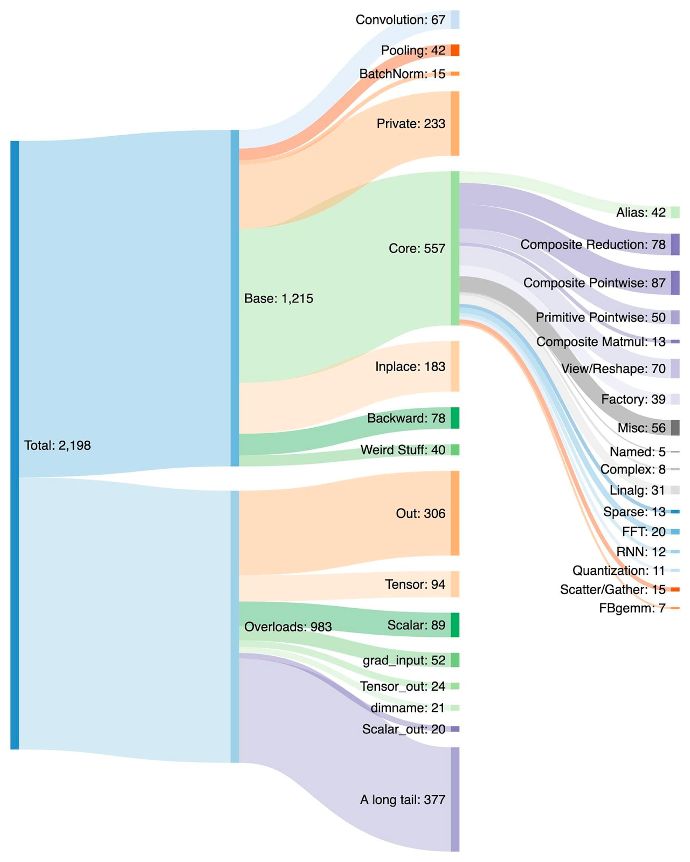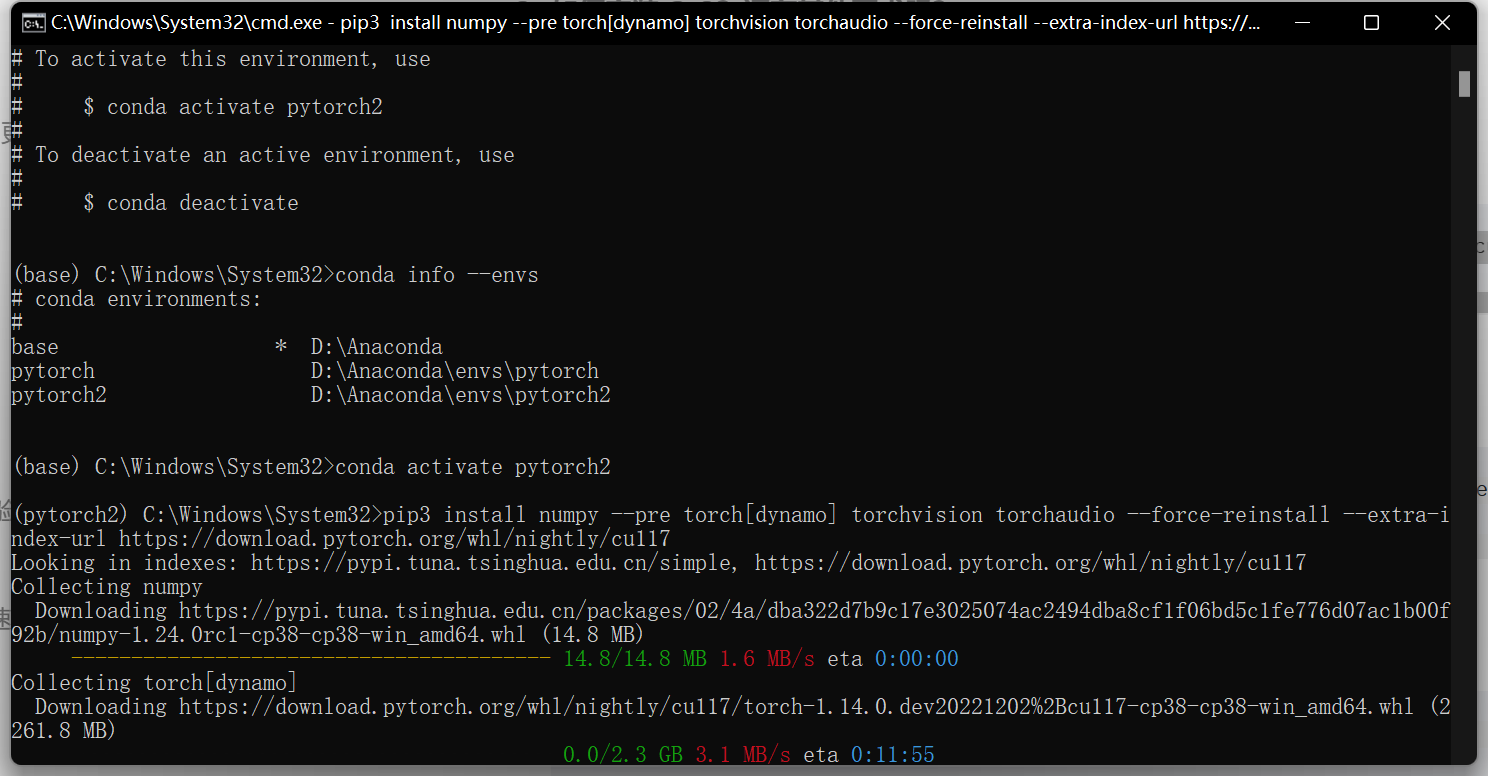pytorch2.0安装与体验
介绍
pytorch2.0 相对1.x进行了大版本更新,向下兼容!!!!通过官网阅读可知他最大的更新是torch.compile(),通过编译的方式,用一行代码实现模型的稳定加速。
compiled_model = torch.compile(model)
这个语句返回一个原来模型的引用,但是将forward函数编译成了一个更优化的版本。
官方同时提供一些参数可以使用:
def torch.compile(model: Callable,
*,
mode: Optional[str] = "default",
dynamic: bool = False,
fullgraph:bool = False,
backend: Union[str, Callable] = "inductor",
# advanced backend options go here as kwargs
**kwargs
) -> torch._dynamo.NNOptimizedModule
可以用来做一些更加细节的指定。
- mode specifies what the compiler should be optimizing while compiling.
- The default mode is a preset that tries to compile efficiently without taking too long to compile or using extra memory.
- Other modes such as reduce the framework overhead by a lot more, but cost a small amount of extra memory. compiles for a long time, trying to give you the fastest code it can generate.
reduce-overhead max-autotune
- dynamic specifies whether to enable the code path for Dynamic Shapes. Certain compiler optimizations cannot be applied to dynamic shaped programs. Making it explicit whether you want a compiled program with dynamic shapes or with static shapes will help the compiler give you better optimized code.
- fullgraph is similar to Numba’s . It compiles the entire program into a single graph or gives an error explaining why it could not do so. Most users don’t need to use this mode. If you are very performance conscious, then you try to use it.
nopython - backend specifies which compiler backend to use. By default, TorchInductor is used, but there are a few others available.
官方测试
PyTorch 2.0 中支撑 torch.compile 的最新技术包括:
TorchDynamo、AOTAutograd、PrimTorch 以及 TorchInductor。
为了验证这些技术,PyTorch 官方使用了机器学习领域的 163 个开源模型,包括图像分类、目标检测、图像生成等任务,以及各种 NLP 任务,如语言建模、问答、序列分类、推荐系统和强化学习。这些 Benchmark 分为三类:
* 来自 HuggingFace Transformers 的 46 个模型
* 来自 TIMM 的 61 个模型:由 Ross Wightman 收集的 SoTA PyTorch 图像模型
* 来自 TorchBench 的 56 个模型:GitHub 上收集的一组流行代码库。
对于开源模型,PyTorch 官方没有进行修改,只是增加了一个 torch.compile 调用来进行封装。
接下来 PyTorch 工程师在这些模型中测量速度并验证精度,由于提速可能取决于数据类型,因此官方在 float32 和自动混合精度(AMP) 上都测量了提速。由于 AMP 在实践中更常见,测试比例设定为:0.75 * AMP + 0.25 * float32 的。
在这 163 个开源模型中,torch.compile 可以在 93% 模型上正常运行,运行过后,模型在 NVIDIA A100 GPU 上的运行速度达到了 43% 的提升。在 Float32 精度下,运行速度平均提升 21%;在 AMP 精度下,运行速度平均提升 51%。
注意:在桌面级 GPU(如 NVIDIA 3090)上,测得的速度比在服务器级 GPU(如 A100)上要低。截至目前,PyTorch 2.0 默认后端 TorchInductor 已经支持 CPU 和 NVIDIA Volta 和 Ampere GPU,暂不支持其他 GPU、xPU 或更老的 NVIDIA GPU。
这个新API后面的四项新技术
TorchDynamo使用Python Frame Evaluation Hooks,安全地捕获PyTorch程序,这是我们5年来在安全图形捕获方面研发的一项重大创新。
AOTAutograd重载了PyTorch的autograd引擎,作为一个追踪的autodiff,用于生成ahead-of-time的backward追踪。
PrimTorch将约2000多个PyTorch运算符归纳为约250个原始运算符的封闭集,开发人员可以针对这些运算符建立一个完整的PyTorch后端。这大大降低了编写PyTorch功能或后端的障碍。
TorchInductor是一个深度学习编译器,可以为多个加速器和后端生成快速代码。对于英伟达GPU,它使用OpenAI Triton作为关键构建模块。
1. TorchDynamo
TorchDynamo 使用了PEP-0523中引入的CPython 功能,称为框架评估 API (Frame Evaluation API)。官方采取了一种数据驱动的方法来验证其在 Graph Capture 上的有效性,使用 7000 多个用 PyTorch 编写的 Github 项目作为验证集。
实验表明,TorchDynamo 在 99% 的时间里都能正确、安全地获取图结构,而且开销可以忽略不计,因为它无需对原始代码做任何修改。
2. AOTAutograd
PyTorch 2.0 要想加速训练,不仅要捕获用户级代码,而且要捕获反向传播算法(backpropagation)。如果能用上经过验证的 PyTorch autograd system就更好了。
AOTAutograd 利用 PyTorch torch_dispatch 扩展机制来追踪 Autograd engine,使开发者得以「ahead-of-time」捕获反向传播 (backwards pas),从而使开发者得以使用 TorchInductor 加速 forwards 和 backwards pass。
3. PrimTorch
为 PyTorch 写一个后端并不容易,PyTorch 有 1200+ 算子,如果考虑到每个算子的各种重载 (overload),数量高达 2000+。

因此,编写后端或交叉功能(cross-cutting feature) 成为一项耗费精力的工作。PrimTorch 致力于定义更小更稳定的算子集。PyTorch 程序可以持续降级 (lower) 到这些算子集。官方的目标是定义两个算子集:
* Prim ops 包含约 250 个相对底层的算子,因为足够底层,所以这些算子更适用于编译器,开发者需要将这些算子进行融合,才能获得良好的性能。
* ATen ops 包含约 750 个典型算子 (canonical operator),适合于直接输出。这些算子适用于已经在 ATen 级别上集成的后端,或者没有经过编译的后端,才能从底层算子集(如 Prim ops) 恢复性能。
4. TorchInductor
越来越多的开发者在编写高性能自定义内核时,会使用 Triton 语言。此外,对于 PyTorch 2.0 全新的编译器后端,官方还希望能够使用与 PyTorch eager 类似的抽象,并且具有足够的通用性能支持 PyTorch 中广泛的功能。
TorchInductor 使用 Pythonic define-by-run loop level IR,自动将 PyTorch 模型映射到 GPU 上生成的 Triton 代码以及 CPU 上的 C++/OpenMP。
TorchInductor 的 core loop level IR 只包含大约 50 个算子,而且是用 Python 实现的,这使得它具有很强的 hackability 和扩展性。
TorchDynamo、AOTAutograd、PrimTorch和 TorchInductor 是用 Python 编写的,并且支持 dynamic shape(无需重新编译就能发送不同大小的向量),这使得它们灵活且易学,降低了开发者和供应商的准入门槛。
安装
因为之前在conda装过pytorch_1.x所以cuda也有是11.7版本
这次只需要在conda直接创建一个环境安装pytorch2.0-cuda11.7版本
官方给出的安装命令
cuda11.6
pip3 install numpy --pre torch[dynamo] torchvision torchaudio --force-reinstall --extra-index-url https://download.pytorch.org/whl/nightly/cu116
cuda11.7
pip3 install numpy --pre torch[dynamo] torchvision torchaudio --force-reinstall --extra-index-url https://download.pytorch.org/whl/nightly/cu117
cpu
pip3 install numpy --pre torch torchvision torchaudio --force-reinstall --extra-index-url https://download.pytorch.org/whl/nightly/cpu
具体的安装步骤:
-
创建新环境
conda create -n pytorch2 python=3.8 -
切换到pytorch2
conda activate pytorch2 -
安装pytorch2.0 使用上面的对应命令


使用
这里的使用主要是使用呢一行代码
官方给出的样例:
现在,让我们看一个编译真实模型并运行它的完整示例(使用随机数据)
import torch
import torchvision.models as models
model = models.resnet18().cuda()
optimizer = torch.optim.SGD(model.parameters(), lr=0.01)
compiled_model = torch.compile(model)
x = torch.randn(16, 3, 224, 224).cuda()
optimizer.zero_grad()
out = compiled_model(x)
out.sum().backward()
optimizer.step()
第一次运行时,它会编译模型。因此,运行时间更长。后续运行速度很快。compiled_model(x)
不同的模式
编译器具有一些预设,这些预设以不同的方式调整已编译的模型。 您可能正在运行的小型模型由于框架开销而运行缓慢。或者,您可能正在运行一个几乎不适合内存的大型模型。根据您的需要,您可能需要使用其他模式。
# API NOT FINAL
# default: optimizes for large models, low compile-time
#默认值:针对大型模型进行优化,编译时间短
# and no extra memory usage
# 并且没有额外的内存使用
torch.compile(model)
# reduce-overhead: optimizes to reduce the framework overhead
#减少开销:优化以减少框架开销
# and uses some extra memory. Helps speed up small models
# 并且使用一些额外的内存。有助于加快小型模型的速度
torch.compile(model, mode="reduce-overhead")
# max-autotune: optimizes to produce the fastest model,
#最大自动调谐:优化以产生最快的模型,
# but takes a very long time to compile
# 但编译需要很长时间
torch.compile(model, mode="max-autotune")
注意
- Are there any applications where I should NOT use PT 2.0?
The current release of PT 2.0 is still experimental and in the nightlies. Dynamic shapes support in torch.compile is still early, and you should not be using it yet, and wait until the Stable 2.0 release lands in March 2023. That said, even with static-shaped workloads, we’re still building Compiled mode and there might be bugs. Disable Compiled mode for parts of your code that are crashing, and raise an issue(if it isn’t raised already).
文章出处登录后可见!
